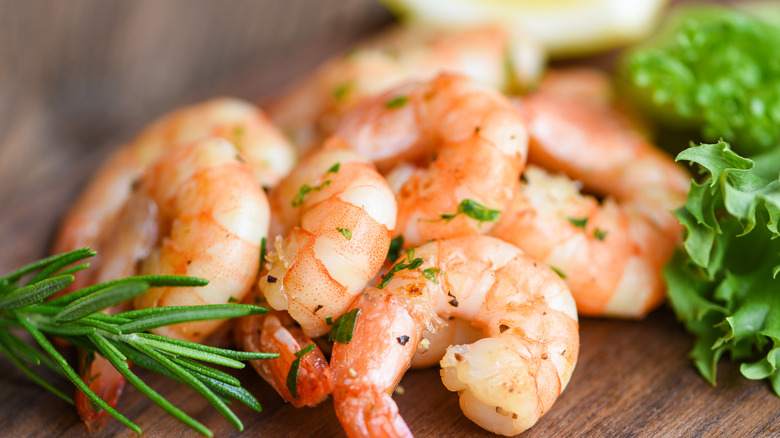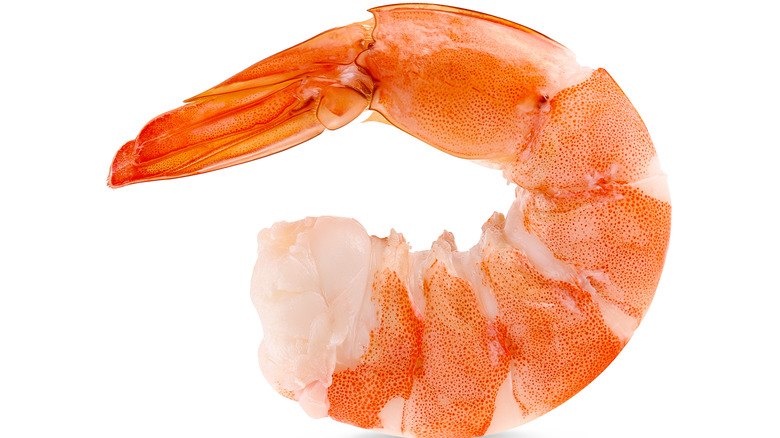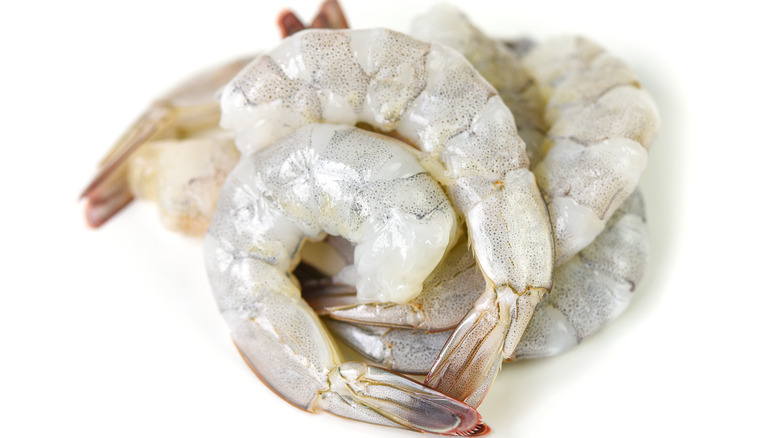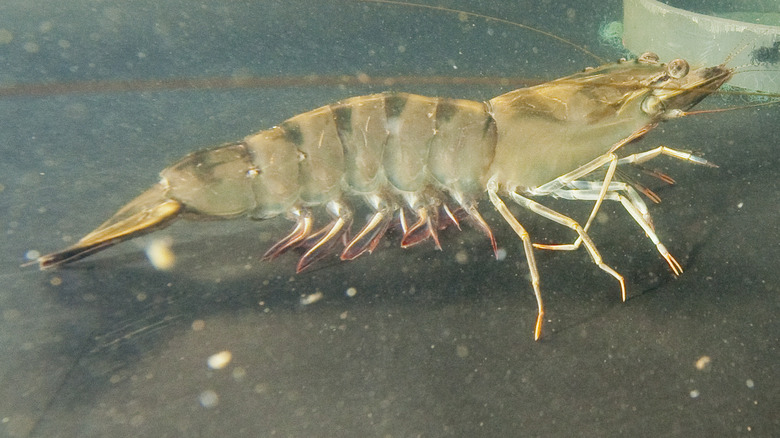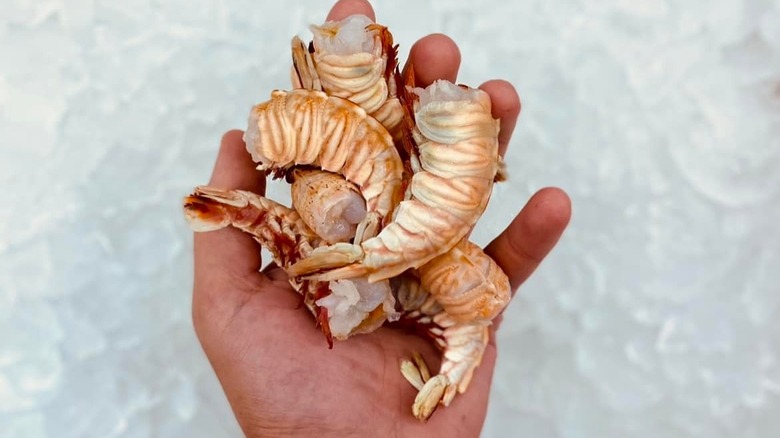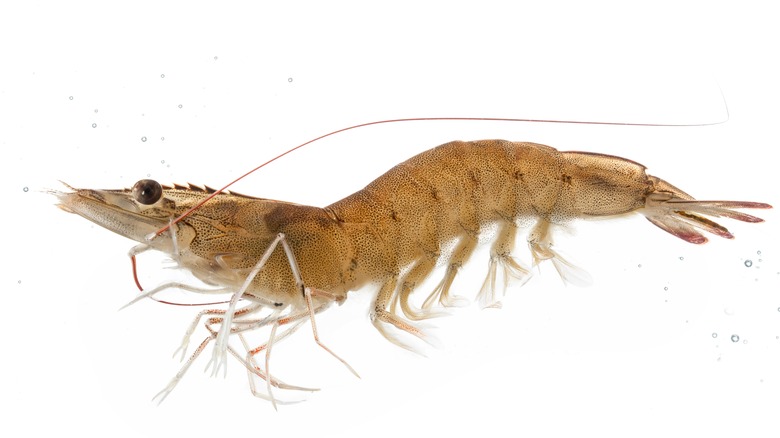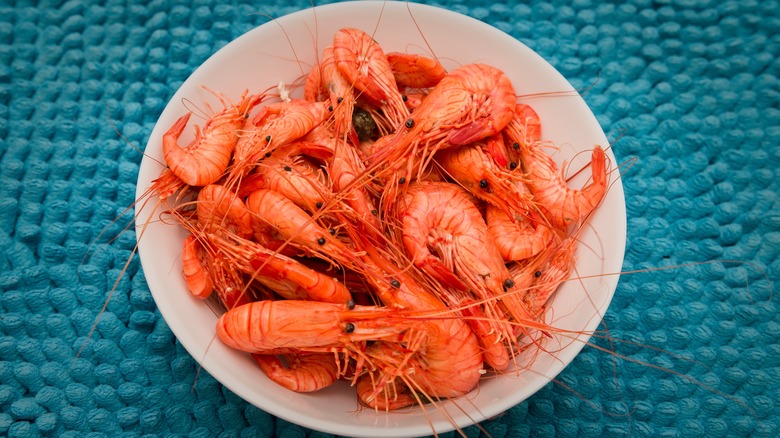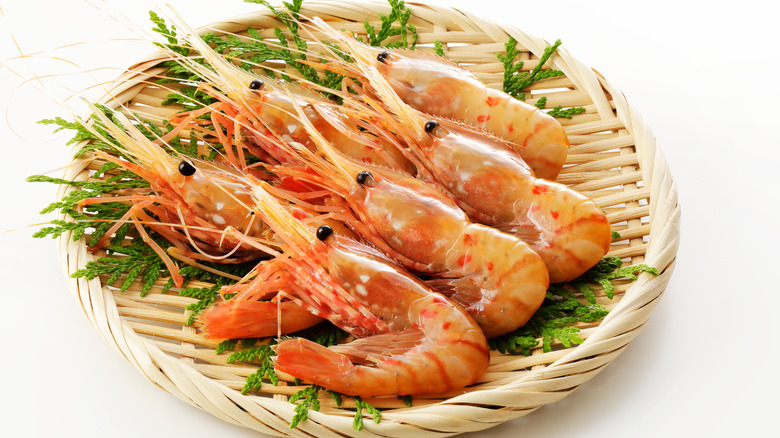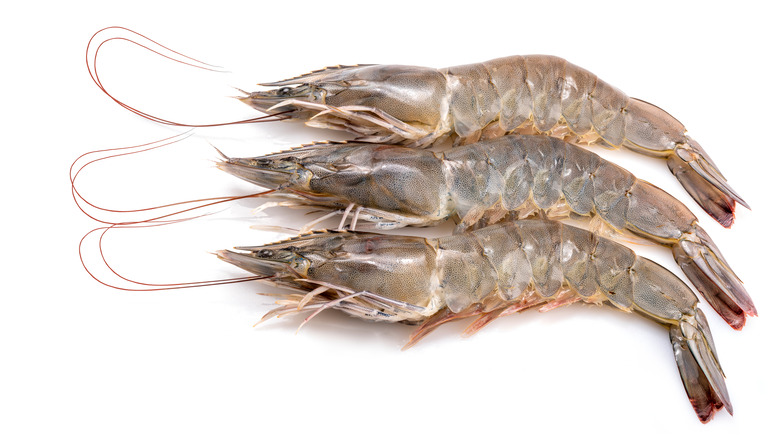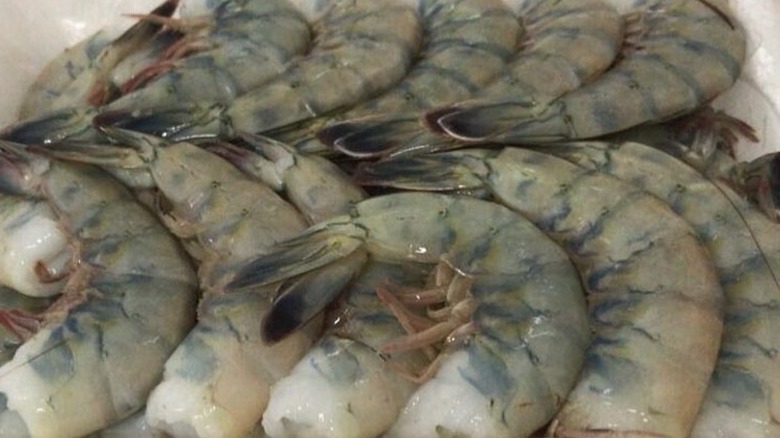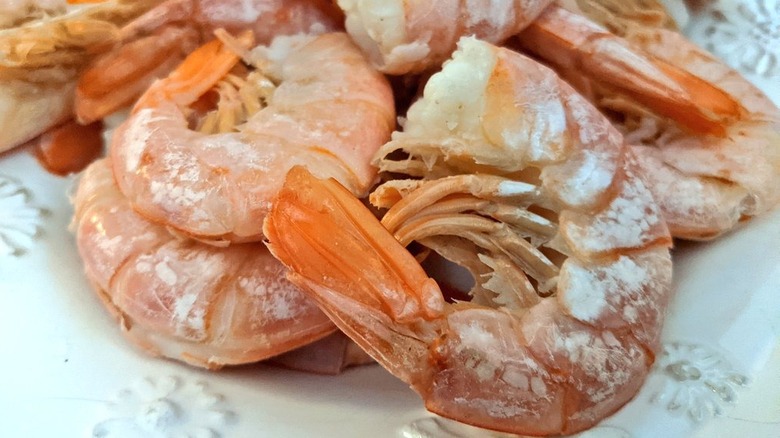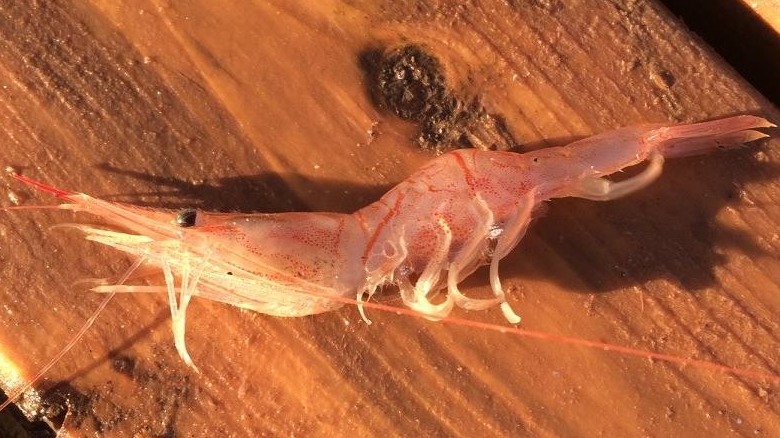11 Types Of Shrimp Varieties From Around The World
There's a reason why delicate shrimp meat is so deeply embedded in American cuisine. Sweet, tender, and succulent, fresh shrimp meat drizzled with melted garlic butter is unparalleled. While shrimp was previously considered an expensive delicacy, primarily for the rich and fancy, it has now become a routine addition to our diets almost everywhere across the globe (via Food of History).
But with over 300 separate species of shrimp and prawns found worldwide, how do you pick the best one? Since they come in varying sizes, forms, species, and habitats, their flavor profiles are vastly different. Not all shrimp make for a tasty meal on the plate.
If you are a connoisseur looking to give your customers the best experience or simply a seafood lover who wants to explore unique shellfish varieties, here are 11 different types of shrimps from all over the world along with various chef-approved tips on the best ways to cook each prized crustacean.
1. Pink shrimp
Topping our list of shrimp varieties from around the world is pink shrimp. Yes, you heard that right. Shrimps aren't just white and grey. They're also pink. Pink shrimp are your cold-weather species, peaking from late fall until early spring. You'll usually see these little guys behind the seafood counter. According to Joe Gurrera, owner of the Citarella Gourmet Market, pink shrimps are a South American variety that is not as common as white or brown shrimp.
"Pink shrimp have a pretty wide range that stretches from the waters of the southern Chesapeake Bay all the way down to the Florida Keys and through the southern Gulf of Mexico (via Fisheries.noaa). Pink shrimps aren't just beautiful to look at; they also taste incredible. Known for their sweet, tender meat, they have a better taste profile than most warm water crustacean varieties.
A live pink shrimp tail is usually red in color instead of pink, while the shell and body are transparent. Once cooked, the shell turns pink (hence the name), and the flesh turns solid white with pink-colored spots. Look for an unpleasant smell while shopping for pink shrimp, the most common sign of degradation, as per Caspian Monarque.
2. White shrimp
All hail white shrimp, aka king prawn. Fry 'em, bake 'em, steam 'em, or eat them raw in your favorite sushi recipe; there's literally nothing you can't do with these beauties. And since this sweeter, albeit nuttier shrimp variety is so incredibly versatile, it's among the most popular shrimp variety for several chefs.
If you pick one of them, chances are that they will exceed your palm size. With 7 to 8 inches of body size, white shrimp are one of the largest shrimp species. Found in areas with less salinity like the coastal waters of New York, Florida, and the Gulf of Mexico, these white shrimp don't like to stay as anonymous as some deep water shrimp varieties. Fishermen find them only at 90 feet of ocean depth. However, they can only survive a year or two at most (via The National Wildlife Federation).
The cooking part has no rocket science attached. It's simple, but get ready for a rubbery outcome if you overcook them. According to Marine Species, white shrimp can be used in various shrimp recipes, but they taste incredibly delicious in soup with a dash of lemon juice to enhance the natural flavors. Besides soup, you can also use them in sauces, stews, and pasta.
Although they aren't exactly endangered, the fishing method used in catching white shrimp is dangerous for marine life. Fisheries use the bottom trawling method, which uses heavy nets that drag the seafloor to catch shrimp. This fishing method ultimately disturbs other marine species on the seafloor.
3. Tiger shrimp
Spoiler alert: tigers don't only live in jungles. Some live in the sea too, but they are not the big-pawed cats we are familiar with. Tiger shrimps come with black bands (similar to ones you find on a tiger) encircling their shells. The species is also known as black tiger shrimp. These little fellas are native to India and Southeastern Asia.
When it comes to cooking them, tiger shrimps work exceptionally well in shrimp cocktails and grilled on skewers. Moreover, they are a fantastic ingredient to add to your casseroles and pasta, but you need to closely monitor the cooking process since they overcook quickly. According to Seafoodsource, large tiger shrimp tails can make delicious European appetizers (hors d'oeuvres). As per Seapedia, the taste is somewhat bland, so they will go well with rich sauces and herbs, including thyme, parsley, and oregano.
Don't be alarmed when the black stripes turn bright red while cooking them. It's perfectly natural. These shrimp have an average length of 9 to 11 inches (yes, they are huge!). Keep in mind that if you see 16/20 on the label, this means that there will be 16 to 20 tiger shrimp in the pound. The lower the number, the bigger the shrimp will be. Tiger shrimps are generally sold raw with tails on. These shrimps are usually classified as jumbo or large, and there's a per-pound count of tiger shrimps you can see on most of the labels (via Tensuke.com).
4. Rock shrimp
Another warm-water shrimp dweller on this global crustacean tour, rock shrimps( also knowns as sicyonia brevirostris or brown rock shrimp) have a hard-as-a-rock shell and take shelter in the warm water waters of the Atlantic Ocean; all the way from Florida down to the Gulf of Mexico, Cuba, and the Caribbean (via Seapedia).
According to Captandersons, rock shrimps weren't marketed widely since the hard, exoskeleton shell is incredibly tough to break. Fortunately, we've come a long way since then. Machines are now available to help break the shell and devein the shrimp. While rock shrimps can be classified as prawns, these armor-plated shrimps are widely underrated. Yes, getting to the meat through the hard shell is trouble. However, these sweet and briny creatures are definitely worth it.
From frying, and baking to grilling, marinating, and steaming, cooking techniques for rock shrimp are practically limitless. According to chef Brian Malarkey, the best way to fully appreciate the taste of rock shrimp is cooked in M-80 sauce and served with slaw. Just keep in mind that it cooks faster than other shrimp varieties. So, turn down that flame and keep the cooking time to a few minutes, depending on the recipe, of course.
5. Brown shrimp
They are smart, they are adaptive, and they are brown. Brown shrimp (also known as common shrimp) lives in shallow water bodies like estuaries. Due to their blotched brown color, brown shrimps stay safe against predators by burying themselves in the seabed. The species usually live on muddy shores where it is convenient for them to camouflage (via Wildlifetrusts.org).
According to Fisheries.noaa, these shrimps have 10 walking legs and five pairs of swimming legs near their abdomen and are commonly characterized by a purple band around their tails. The species has a short life span of almost two years. Since their diet is rich in iodine, brown shrimps have a strong taste and pair well with mildly-flavored sauces (via Eat Alabama Seafood).
As per the Great British Chefs, Brown shrimps are usually sold pre-cooked. If buying raw, you simply need to boil them in salted boiling water for 45 seconds to a minute before peeling them. On the taste part, brown shrimps are sweet and salty. Its umami flavor goes great with other seafood species. Add lemon juice to truly bring out the umami flavors. In South-East Asian cuisine, brown shrimps are dried to preserve the flavor. Once dried, they are fermented to make a pungent sauce which are often added to soups, stews, and curries.
6. Atlantic northern shrimp
The next time you're in a seafood restaurant and want to try something different, order the Atlantic northern shrimp. As per the Canadian Governments Fisheries, they live in the Northern Atlantic and Pacific Oceans, making a long journey to high-end restaurant kitchens. The species thrives in colder waters with a temperature range of 2 to 6 degrees celsius.
Northern shrimps are crustaceans, just like all the other shrimp species on the list. However, they have a relatively hard outer shell that encloses its body with six walking legs and four for feeding below. With an average life span of eight years, these pink to red-hued shrimps can grow up to 15 centimeters (the average size is half the potential size, though).
Northern shrimps have a transparent and jelly-like body when raw. Once cooked, the flesh turns solid white with a blotched pink hue. Definitely a pretty sight (via Namanet). Like rock shrimp, when Northern shrimp are shells-on, you must add them to salted boiling water (you can replace salt with vinegar or lemon juice, too) for nearly 45 seconds. Next, stir the water quickly and discard the boiling water at the one-minute mark. Lastly, rinse the shrimp with cold water to preserve its taste.
7. Spot shrimp
Keeping to the name, spot shrimp is a cold water shrimp variety native to the Alaskan waters, ranging from the Aleutian Islands to San Diego. This variety of shrimp gets its name through the distinctive white spots on the first and fifth segment of the exoskeleton over the abdominal cavity (via Adfg.alaska)
Sitka Salmon Shares advises peeling off the exoskeleton when the shrimp is slightly defrosted. This is because the flesh of these beauties is super delicate, and peeling them fresh will usually leave some parts attached to the inner side of the exoskeleton.
An article on Champagne-taste describes the taste of Spot shrimp as nothing like the regular shrimp we eat. Instead, they are buttery and sweet, similar to cold water lobsters. According to Rob Clark – the chef who brought British Columbian spot shrimp to the Canadian masses — throwing the live spot shrimp on a grill is the best way to eat them. Once they turn slightly pink, grease them with melted butter.
8. Banana shrimp
If you have tasted banana shrimp or prawns, you know what the fuss is about. If you haven't, it's time to try them. Banana prawns, aka Indian white prawns, are a seafood staple in the Southeast Asian regions. The shrimp variety is commonly used in Indian, Chinese, and Thai cuisine due to its unmatchable flavor when paired with spicy ingredients.
As per Australia Fisheries Management Authority, the size of banana prawns falls between 14-17 cm on average. However, the prawns can occasionally grow up to 25 cm as well. These prawns take four to six months to grow to the ideal size for harvesting. The harvesting is carried out by otter trawls that do not disturb the seabed because the prawns aren't harvested in their habitat (via Goodfish.org.au).
The name banana prawn stems from its physical appearance; a prawn in the shape of a banana. And just like a banana, it is incredibly sweet. Interestingly enough, banana prawns retain their shape even after cooking. You can enjoy them lightly fried or barbecued. Since they are mildly flavored, banana prawns are also used in prawn cakes or terrines (via Australiantropicalfoods).
9. Mexican blue shrimp
You might have come across Mexican blue shrimp on a restaurant menu and wondered if it's merely colored or actually blue. Spoiler alert: the latter is, in fact, true.
Mexican blue shrimps have a maximum length of 10.75 inches and a bluish-grey color. These shrimp are heavily harvested in two regions of the Mexican Pacific: Sinaloa and Sonora. However, the regions do not have sustainable fishing practices, so there's heavy bycatch and destruction to the sea beds (via Mexican-fish).
According to Crowd Cow, Mexican blue shrimp have a sweet, crisp flavor with the perfect snap. The website says that the best way to enjoy these robust shrimps is by pan-searing them in olive oil for two to three minutes until they turn pink, accompanied by a generous seasoning of salt and pepper and drizzled with a rich garlic-butter sauce. Pairing the Mexican blue shrimp with acidic or citric sauces will balance out its sweetness. Besides that, herby sauces like pesto or chimichurri also pair well with the blue shrimp.
10. Royal red shrimp
What if we told you that shrimp comes in colors other than just white, brown, and grey? Yes, that's right. Red shrimp is real. What's more, it's extremely rare and widely popular too. With their rich butter flavor and firm texture, royal reds are often compared to lobsters. So, you don't need to pair them with a strong sauce.
Native to the Atlantic, these huge crimson shrimps are some of the finest shrimps on our list. If you're getting them with their heads-on and they haven't turned black yet, consider yourself lucky. The heads start rotting as soon as they are out of seawater. Since royal reds can't be found any sooner than 500 feet mark (they can go as deep as 2,000 feet), expect them to have that incredible deep-sea water saltiness, which is exactly what gives it that unique flavor profile (via Honest-food).
Eat Alabama Sea Food warns not to overdo the cooking. These red beauties only take half the time to cook compared to pink, white, or brown shrimp. Another point to keep in mind is to season the royal reds light-handedly because they are already rich in salt. You can use Royal Reds in various shrimp recipes, but the best way to fully appreciate these flavorsome shrimps is cooked with butter, fresh garlic, white wine, and lemon juice and enjoyed with an icy cold beverage.
11. Aesop shrimp
Last on the shrimp tour is aesop shrimp, a pink-shrimp look-alike with sweet and delicate meat. Aesop shrimp (which is also referred to as pink-striped shrimp) are more distinctive from the common shrimp varieties. They have pink stripes over their bodies due to pigmented cells and chromatophores.
So, what makes this shrimp variety unique? Aesop shrimps can grow well over 50 mm in length, found on the British and Irish coasts. Generally, these shrimp live in deep waters (up to 100 meters), but they are also occasionally found in shallow rock pools (via Marlin.ac.uk)
Since it's a cold water shrimp variety, aesop shrimps are super sweet. While they are primarily used in shrimp cocktails, you can also add them to your salads and cold platters. Opt for a summer salad with chunks of shrimp meat judiciously dressed in olive oil, lemon juice, chopped parsley, garlic powder, black pepper, and a dash of salt (via Tasting Table).
